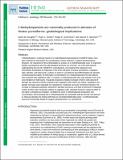| dc.contributor.author | Doughty, David M. | |
| dc.contributor.author | Hunter, Ryan C. | |
| dc.contributor.author | Summons, Roger Everett | |
| dc.contributor.author | Newman, Dianne K. | |
| dc.date.accessioned | 2012-10-22T19:49:53Z | |
| dc.date.available | 2012-10-22T19:49:53Z | |
| dc.date.issued | 2009-10 | |
| dc.date.submitted | 2009-06 | |
| dc.identifier.issn | 1472-4677 | |
| dc.identifier.issn | 1472-4669 | |
| dc.identifier.uri | http://hdl.handle.net/1721.1/74192 | |
| dc.description.abstract | 2-Methylhopanes, molecular fossils of 2-methylbacteriohopanepolyol (2-MeBHP) lipids, have been proposed as biomarkers for cyanobacteria, and by extension, oxygenic photosynthesis. However, the robustness of this interpretation is unclear, as 2-methylhopanoids occur in organisms besides cyanobacteria and their physiological functions are unknown. As a first step toward understanding the role of 2-MeBHP in cyanobacteria, we examined the expression and intercellular localization of hopanoids in the three cell types of Nostoc punctiforme: vegetative cells, akinetes, and heterocysts. Cultures in which N. punctiforme had differentiated into akinetes contained approximately 10-fold higher concentrations of 2-methylhopanoids than did cultures that contained only vegetative cells. In contrast, 2-methylhopanoids were only present at very low concentrations in heterocysts. Hopanoid production initially increased threefold in cells starved of nitrogen but returned to levels consistent with vegetative cells within 2 weeks. Vegetative and akinete cell types were separated into cytoplasmic, thylakoid, and outer membrane fractions; the increase in hopanoid expression observed in akinetes was due to a 34-fold enrichment of hopanoid content in their outer membrane relative to vegetative cells. Akinetes formed in response either to low light or phosphorus limitation, exhibited the same 2-methylhopanoid localization and concentration, demonstrating that 2-methylhopanoids are associated with the akinete cell type per se. Because akinetes are resting cells that are not photosynthetically active, 2-methylhopanoids cannot be functionally linked to oxygenic photosynthesis in N. punctiforme. | en_US |
| dc.description.sponsorship | United States. National Aeronautics and Space Administration (NASA Exobiology and Astrobiology Programs) | en_US |
| dc.description.sponsorship | Howard Hughes Medical Institute (Investigator) | en_US |
| dc.language.iso | en_US | |
| dc.publisher | John Wiley & Sons, Inc. | en_US |
| dc.relation.isversionof | http://dx.doi.org/ 10.1111/j.1472-4669.2009.00217.x | en_US |
| dc.rights | Creative Commons Attribution-Noncommercial-Share Alike 3.0 | en_US |
| dc.rights.uri | http://creativecommons.org/licenses/by-nc-sa/3.0/ | en_US |
| dc.source | PubMed Central | en_US |
| dc.title | 2-Methylhopanoids are maximally produced in akinetes of Nostoc punctiforme: geobiological implications | en_US |
| dc.type | Article | en_US |
| dc.identifier.citation | Doughty, D. M. et al. “2-Methylhopanoids Are Maximally Produced in Akinetes of Nostoc Punctiforme : Geobiological Implications.” Geobiology 7.5 (2009): 524–532. Web. | en_US |
| dc.contributor.department | Massachusetts Institute of Technology. Department of Biology | en_US |
| dc.contributor.department | Massachusetts Institute of Technology. Department of Earth, Atmospheric, and Planetary Sciences | en_US |
| dc.contributor.mitauthor | Doughty, David M. | |
| dc.contributor.mitauthor | Hunter, Ryan C. | |
| dc.contributor.mitauthor | Summons, Roger Everett | |
| dc.contributor.mitauthor | Newman, Dianne K. | |
| dc.relation.journal | Geobiology | en_US |
| dc.eprint.version | Author's final manuscript | en_US |
| dc.type.uri | http://purl.org/eprint/type/JournalArticle | en_US |
| eprint.status | http://purl.org/eprint/status/PeerReviewed | en_US |
| dspace.orderedauthors | DOUGHTY, D. M.; HUNTER, R. C.; SUMMONS, R. E.; NEWMAN, D. K. | en |
| dc.identifier.orcid | https://orcid.org/0000-0002-7144-8537 | |
| dspace.mitauthor.error | true | |
| mit.license | OPEN_ACCESS_POLICY | en_US |
| mit.metadata.status | Complete | |
